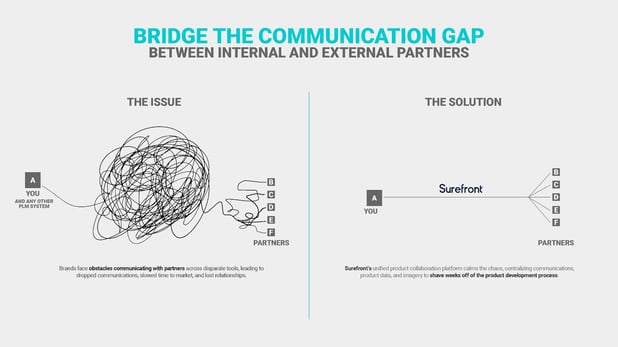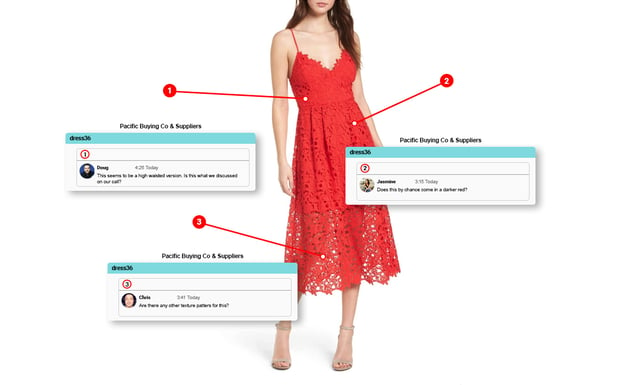Share this
Product Showcases Can Make or Break Your Business
by Surefront on Apr 7, 2023 10:19:35 AM
Home > Blog > Product Showcases Can Make or Break Your Business
Table of Contents
- The current state of the retail industry
- What is a product showcase?
- What are the benefits of product descriptions?
- What are the benefits of product showcases?
- How do you make a product showcase?
- Features to look for in a product showcasing platform
We often talk about product showcases in terms of B2C businesses. Customer-facing retail businesses do need to know how to showcase a product effectively; but it is equally, if not more important, for B2B companies to master the fine art of product showcasing. The reason? Suppliers operate with thinner margins, so inflation poses a larger threat to suppliers’ businesses.
This means suppliers will need to fortify their business communication. Although communication is the arena where most retail teams are lacking, few even realize that there is a better way to do things. By identifying where communication can be refined, and taking steps to correct it, retail teams can shave days off of their product quote and order process. Learning how to showcase a product is the first step.
Want to know how product showcases can help differentiate your B2B retail business? Let’s define “product showcasing,” review its benefits, and discuss how you can create tailored product showcases for different customers from the same system.
The current state of the retail industry
A whopping 64% of global businesses are still recovering from the negative financial impacts of the pandemic. To contend with increased shipping costs and delayed/canceled shipments, retailers are diversifying their supplier catalog so as not to rely too heavily on one region or supplier. While this creates more opportunities for little known suppliers, it also means that retaining retailer clients is more challenging than ever before.
Retailers are also stocking leaner inventories, creating challenges for suppliers that are struggling to meet the same order volume that they had prior to the pandemic. In this oversaturated market, product quality is the main differentiator, and product showcasing is how suppliers communicate that value proposition to the retailers they serve.
What is a product showcase?
First let’s define what we mean by “product showcase.” For the purpose of this article, we’ll focus on B2B product showcases that suppliers create for retailers. Suppliers have had a rough go of it lately. Vogue Business reports, “With the threat of rising costs and inflation, suppliers say closer partnerships, better understanding and greater communication with brands will be more crucial than ever.”
Product showcases are like click-to-order catalogs for B2B businesses. They’re how retailers view your products and work with your team –– often for the first time. Creating a clear communication framework in this step will set the precedent for a profitable retailer/supplier relationship. Retailers have a lot of options in this day and age. Transparent, real-time product communication can be the competitive differentiator that sets your company apart from the droves.

What are the benefits of product descriptions?
Product descriptions aren’t just for B2C marketplaces. They can give retailers critical insights into your product catalog and help your team showcase products in a way that demonstrates value. The product descriptions you’ll use for product showcasing will only be a few words, so it’s important to pack all of the relevant details into that product description.
If you use a collaboration platform with the ability to create product showcases, you may also be able to select the features you show each retailer. Features such as: product components, freight shipping rates, colors, number of products, etc. can help you do more than just enhance and expedite sales. They can also help you enhance your bottom line. The ability to weigh the cost of materials, check historical sales data, communicate with clients, and chat with manufacturers in the same app will help to maximize ROI by reducing production costs.
What are the benefits of product showcases?
The benefits of product showcases are myriad. Adding products to your customer’s product showcase lets them see what products you think they will find interesting. They can easily select the products they are interested in getting a quote for, or learning more about. Any products you share in a showcase can be reordered, or quickly added to a quote for additional pricing options. So your clients can easily find a deal that works for them, every time.

Have no fear if, like most suppliers, your business experienced drastically lower order volumes this year. Product showcasing might be just the secret sauce to accelerate sales at your company. By allowing sales managers to get products seen quickly, you can easily start fulfilling orders. Product showcases can also drastically reduce the time it takes to turn quotes into orders to increase revenue per employee by up to 150%.
How do you make a product showcase?
Product showcases are all about communicating value, and product quality is at the heart of each product's value proposition. The ability to demonstrate product quality is one of the benefits of product showcases. But how can you showcase a product in a way that conveys product quality as part of its value proposition? Product quality is considered an objective factor, rather than subjective. Without including product details and images that communicate that quality, however, brands often fail to communicate how product quality is part of that value proposition.
Product showcases let you showcase products in the best possible light. By using customer data to tailor your table view, you can meet the exact specifications of your buyers. But, this still doesn’t tell us how to create a product showcase. Every platform is slightly different but, to give you an idea, here are the steps to take to create a product showcase in Surefront:
(1) After you have successfully entered in a new product, you can share it in a Showcase for selected Buyers/Retailers.
(2) To do this, go to your Product Catalog on the top left menu, then click on “Catalog.”
(3) While you’re in the “Products” tab, click on the check box on the bottom left of each item you wish to put in the Showcase.
(4) Click the “Showcase” button in the top right of the page.
(5) You will then see a pop-up window labeled “Add to Showcase”. Here you can invite any of your linked retailers to view the selected items.
(6) Select which Category the items will be displayed under under each Retailer/Buyer you have chosen by clicking the checkbox to the left of each Category under that specific retailer.
Surefront’s unified product collaboration management platform is one of the simplest to use on the market. Of course, all retail software isn’t created equally. To prevent adopting software that’s too complex for your team members to use without lengthy training, and for a demonstration of the features you plan to use, like creating product showcases, before adopting the platform. Click here to learn more about how to create a product showcase from the catalog in Surefront.
Features to look for in a product showcasing platform
Now that you know how to make a product showcase and the benefits that come with product showcasing, it’s time to talk about features. You can’t send the same product showcase to every customer, since the necessary data points vary from business to business. Let’s use freight shipping costs as an example. A client that specializes in luxury jewelry sales won’t rank freight shipping costs as one of their defining factors in choosing a supplier because shipping rates are so low on small items that the data point wouldn’t take precedence. For a major home furnishings wholesaler like JIA HOME, on the other hand, freight shipping is a significant portion of the overall production cost.
Now can you see why you need the ability to create tailored product showcases for different customers from the same system or catalog? Most platforms that offer product showcasing don’t give you the ability to custom select and deselect factors, such as freight shipping costs, for each unique client. However, some solution providers offer features that go way beyond customization to help you solidify sales.
Here are four other features to look for from product showcasing platforms:
1. High definition product images convey the quality of each product. When you make a product showcase, offering 360-degree product views can help enhance the quality perception of your products.
2. Ability to chat with stakeholders in the platform. Without the ability to chat within product showcases, your team will get bogged down by the jumble of Excel docs, emails, and phone calls that plague the rest of the retail industry. Help your sales team, buyers, suppliers, and manufacturers communicate with ease by adopting a collaboration platform with chat functionalities within the product showcase.
3. Access and analyze historical customer data. See what was ordered, what sold and what didn’t. You can then leverage that data, along with current trends, to customize showcases to meet your buyers’ needs.
4. Reduce your administrative task load with automated product data entry. The less manual data input your company depends on, the lower your chance of errors. Ensure you’re presenting the most accurate product information to your buyers, every time.
The retail industry has gotten particularly competitive for suppliers. Communication is the missing ingredient in most supplier/retailer relationships, largely because it’s so challenging to communicate across different platforms. Don’t make buyers work overtime to get the data and product images they need to confirm your product order! The right unified product collaboration platform will help your team showcase products in an accessible, visually robust platform that lets you turn product showcases into quotes, and quotes into orders, with just a few clicks.
Share this
- PLM Software (36)
- PIM Software (29)
- Apparel & Fashion (20)
- Trending Topics (20)
- Merchandising (16)
- CRM Software (13)
- PLM Implementation (11)
- Catalog Management (6)
- Tech Packs (6)
- PLM RFP (5)
- Success Stories (5)
- Sustainability (5)
- Data Import (4)
- Line Sheet (4)
- Luxury Goods & Jewelry (4)
- Product Development (4)
- Retail (4)
- Supply Chain (4)
- Category Management (3)
- Home Furnishings (3)
- Wholesale (3)
- Consumer Packaged Goods (CPG) (2)
- Cosmetics (2)
- Data Export (2)
- Health & Beauty (2)
- RFQ & Quote Management (2)
- Consumer Electronics (1)
- Import & Export (1)
- Industry Events (1)
- Inventory Management (1)
- Pet Stores (1)
- Purchase Orders (1)
- Report Builder (1)
- Textiles & Raw Materials (1)
- Unified Solution (1)
- Vendor Management (1)
- Visual First (1)
- White Paper or Case Study (1)
- workflow (1)
- October 2025 (3)
- September 2025 (3)
- August 2025 (4)
- April 2025 (4)
- March 2025 (3)
- January 2025 (8)
- December 2024 (5)
- November 2024 (3)
- October 2024 (5)
- September 2024 (6)
- August 2024 (2)
- July 2024 (1)
- June 2024 (3)
- May 2024 (4)
- April 2024 (5)
- March 2024 (3)
- February 2024 (2)
- December 2023 (4)
- September 2023 (2)
- August 2023 (5)
- July 2023 (3)
- June 2023 (2)
- May 2023 (2)
- April 2023 (4)
- March 2023 (5)
- February 2023 (3)
- January 2023 (5)
- December 2022 (4)
- November 2022 (3)
- October 2022 (4)
- September 2022 (5)
- August 2022 (4)
- July 2022 (2)
- May 2022 (1)
- February 2022 (1)
- January 2022 (1)
- September 2021 (1)
- May 2021 (1)
- April 2021 (1)
- February 2021 (1)
- May 2020 (1)